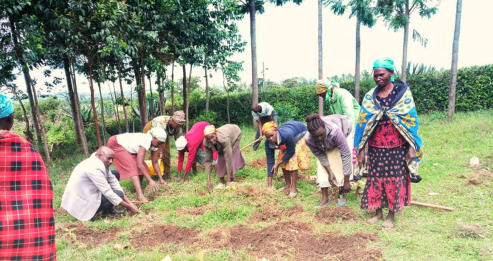


© Chake Conservancy and licensors 2020


Living fences
What if farmers could protect their crops and trees without harming opportunistic African Elephants (Loxodonta africana) that fancy raiding community crops? This is no longer just a dream, within the Conservancy farmers now utilize natively reared honey bees (Apis mellifera scutellata) to protect their crops from damage by elephants. This follows groundbreaking research by a Save The Elephants zoologist Dr. Lucy King (view research). Bees play a very vital role in human animal conflicts solution as they act as a live fence for elephants. The elephants fear the bees as the sting from a bee makes them run madly away. Once they smell honey or hear any sound of the bees they are repelled; thus people can work with nature by helping to send elephants automatically back to the park rather than risking a confrontation. Elephants are better off in the park rather than making a nuisance of themselves and risking retaliation. Farmers also have flash lights which scare lions, leopards and hyenas from invading bomas (defensive corrals) to kill domestic animals. This tactic also has been proving effective. The bees provide valuable pollination services and boost the productivity of the farm as well as helping the wild trees and plants reproduce. Furthermore, the honey can be enjoyed by the farmers’ families and also serve as a valuable cash crop in itself, marketed as “Elephant-friendly Honey”. Sweet! This plan contributes to sustainable development goals 1,2,3,8,11,12,15 & 16.





Trees For Life!
What if the community planted trees for a better life? This is no longer just a dream, within the Conservancy people are doing exactly this. So far the community have planted over 3500. Trees play a very vital role in human and animal welfare. Trees provide food and habitat for wildlife, valuable shade, soil stabilization for control of erosion and shelter from the wind. Trees also serve as carbon sinks, trapping atmospheric Carbon Dioxide in their structure. About 50% of a tree’s weight is carbon. Roots and fallen leaves bring this carbon back into the soil. An area of woodland the size of a football field can sequester about 150 tons of carbon! Chake conservancy plants indigenous trees in the game parks and along the escarpment. Planting trees contributes to sustainable development goals 6 Clean Water And Sanitation, 11 Sustainable Cities and Communities,13 Climate Action and 15 Life On Land.Environmental
Education!
What if the community passed on essential knowledge to new generations? This is an important part of Chake’s mission. We have also introduced environmental clubs in schools to train youth on matters of conservation, wildlife protection and planting trees within the school compound. This contributes to sustainable development goals: 6. Clean Water And Sanitation, 11 Sustainable Cities and Communities,13 Climate Action and 15 Life On Land.











“What a friend we have in a tree, the tree is the symbol of hope, self
improvement and what people can do for themselves. “
Wangari Maathai
Director Charles Kinara with a beehive ready
for deployment as part of the living fence.


© Chake Conservancy and licensors 2020

Living
fences
What if farmers could protect their crops and trees without harming opportunistic African Elephants (Loxodonta africana) that fancy raiding community crops? This is no longer just a dream, within the Conservancy farmers now utilize natively reared honey bees (Apis mellifera scutellata) to protect their crops from damage by elephants. This follows groundbreaking research by a Save The Elephants zoologist Dr. Lucy King (view research). Bees play a very vital role in human animal conflicts solution as they act as a live fence for elephants. The elephants fear the bees as the sting from a bee makes them run madly away. Once they smell honey or hear any sound of the bees they are repelled; thus people can work with nature by helping to send elephants automatically back to the park rather than risking a confrontation. Elephants are better off in the park rather than making a nuisance of themselves and risking retaliation. Farmers also have flash lights which scare lions, leopards and hyenas from invading bomas (defensive corrals) to kill domestic animals. This tactic also has been proving effective. The bees provide valuable pollination services and boost the productivity of the farm as well as helping the wild trees and plants reproduce. Furthermore, the honey can be enjoyed by the farmers’ families and also serve as a valuable cash crop in itself, marketed as “Elephant-friendly Honey”. Sweet! This plan contributes to sustainable development goals 1,2,3,8,11,12,15 & 16.Image copyright and courtesy of Pixabay



Trees For Life!
What if the community planted trees for a better life? This is no longer just a dream, within the Conservancy people are doing exactly this. So far the community have planted over 3500. Trees play a very vital role in human and animal welfare. Trees provide food and habitat for wildlife, valuable shade, soil stabilization for control of erosion and shelter from the wind. Trees also serve as carbon sinks, trapping atmospheric Carbon Dioxide in their structure. About 50% of a tree’s weight is carbon. Roots and fallen leaves bring this carbon back into the soil. An area of woodland the size of a football field can sequester about 150 tons of carbon! Chake conservancy plants indigenous trees in the game parks and along the escarpment. Planting trees contributes to sustainable development goals 6 Clean Water And Sanitation, 11 Sustainable Cities and Communities,13 Climate Action and 15 Life On Land.Environmental
Education!
What if the community passed on essential knowledge to new generations? This is an important part of Chake’s mission. We have also introduced environmental clubs in schools to train youth on matters of conservation, wildlife protection and planting trees within the school compound. This contributes to sustainable development goals: 6. Clean Water And Sanitation, 11 Sustainable Cities and Communities,13 Climate Action and 15 Life On Land.













Director Charles
Kinara with a
beehive ready for
deployment as part
of the living fence.

































